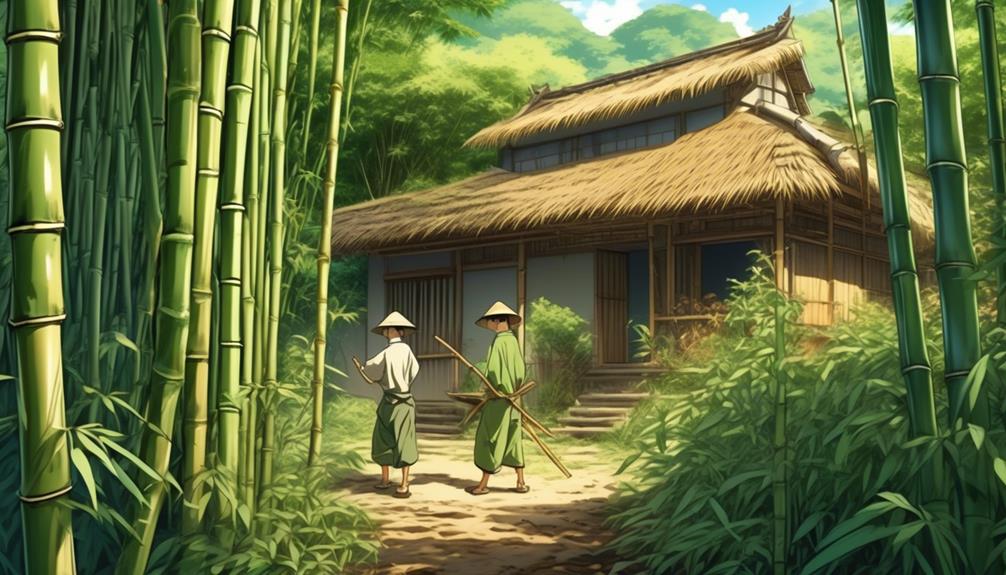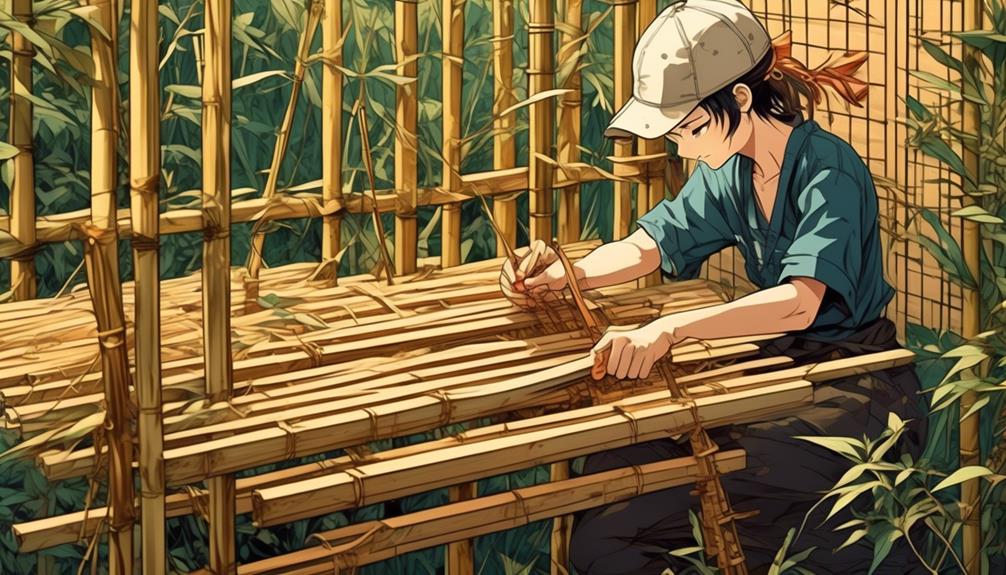Like a towering giant in a lush forest, bamboo stands as a symbol of strength and resilience. With its impressive growth rate and diverse uses, this plant has captured the attention of homesteaders and gardeners alike.
But what makes bamboo the ultimate homestead plant?
What benefits does it bring to a self-sustaining lifestyle? And how can one effectively manage and control its growth?
In this discussion, we will uncover the answers to these questions and more, revealing the hidden potential of bamboo as a sustainable and profitable resource for the modern homesteader.
Prepare to be amazed by the wonders of this remarkable plant and discover how it can transform your homestead into a thriving oasis of productivity and beauty.
Why Bamboo?
- Bamboo is a versatile plant that has been used for thousands of years in countries like Japan and China.
- Bamboo provides various benefits and uses, including privacy, food, building supplies, crafts, and habitat for wildlife.
- Bamboo can be managed and controlled through regular maintenance, understanding growth patterns, and using barriers.
- Growing bamboo on a homestead requires a sizable property or can be done in containers for smaller spaces, and different types of bamboo have specific uses.
Historical Significance of Bamboo
Bamboo holds immense historical significance, as it has been utilized for thousands of years across various cultures and continents for its versatile properties and numerous practical applications.
The cultural impact of bamboo can be seen in countries like Japan and China, where it has been an integral part of their traditions, arts, and everyday life. From constructing buildings and furniture to crafting musical instruments and utensils, bamboo has played a vital role in shaping these cultures.
Additionally, bamboo’s ecological importance can’t be understated.
As one of the fastest-growing plants on Earth, it helps in soil erosion control, water conservation, and carbon sequestration. Its extensive root system also aids in stabilizing slopes and preventing landslides.
Moreover, bamboo is a renewable resource that can be sustainably harvested, making it an environmentally friendly choice for various industries.
Benefits of Bamboo on a Homestead

Using bamboo on a homestead provides numerous benefits due to its versatility and sustainable nature.
- Bamboo is a sustainable resource: Bamboo is a fast-growing plant that can be harvested every 3-5 years without causing harm to the environment. It doesn’t require chemical fertilizers or pesticides, making it an eco-friendly choice for homesteaders.
- Bamboo provides habitat for wildlife: Bamboo groves create a diverse ecosystem, attracting various species of birds, insects, and mammals. It offers nesting sites, food sources, and shelter for wildlife, contributing to biodiversity conservation.
- Bamboo helps prevent soil erosion: The extensive root system of bamboo helps hold the soil together, preventing erosion and protecting against landslides. This is especially beneficial for homesteads located on hilly or sloping terrain.
- Bamboo can be used for construction: Bamboo is a strong and durable building material that can be used for constructing fences, trellises, and even small structures like sheds or greenhouses. It’s lightweight, flexible, and resistant to pests and rot.
- Bamboo has multiple uses: Besides construction, bamboo can be used for crafts, furniture, tools, and even as a source of food. Its versatility makes it a valuable resource for homesteaders, offering endless possibilities for self-sufficiency and creativity.
Managing and Controlling Bamboo Growth

To effectively manage and control the growth of bamboo, it’s important to understand its growth patterns and implement proper maintenance techniques. Bamboo growth control techniques are necessary to prevent bamboo invasiveness and maintain a well-managed homestead.
Regular maintenance is required to prevent bamboo from becoming invasive, and cutting and pruning can help control the size and shape of bamboo.
It’s also possible to limit bamboo spread by mowing, eating, or harvesting shoots. Additionally, using barriers such as fences or flowing creeks can restrict bamboo growth.
Planting bamboo in shaded areas or monitoring its growth during specific months can also help manage and control its growth. By understanding the growth patterns of bamboo and implementing these techniques, homesteaders can effectively manage and control the growth of bamboo on their property.
Growing Bamboo on a Homestead

Growing bamboo on a homestead can provide a sustainable and renewable resource for a variety of purposes. Here are several points to consider when growing bamboo on a homestead:
Proper spacing and containment: Bamboo can spread quickly, so it’s important to plant it in a way that allows for proper spacing and containment. Using barriers or planting in containers can help control its growth and prevent it from becoming invasive.
Soil and sunlight requirements: Bamboo thrives in well-drained soil and full sun. It’s important to choose a location on your homestead that meets these requirements to ensure successful growth.
Harvesting and maintenance: Bamboo can be harvested by cutting mature canes in winter when there are no bugs or snakes. Regular maintenance, such as cutting and pruning, is necessary to control the size and shape of the bamboo.
Selecting the right variety: It’s important to consider the specific variety of bamboo you are planting. There are many different types of bamboo, each with its own growth habits and requirements. Some varieties are more suitable for ornamental purposes, while others are better suited for privacy screens or erosion control.
When planting bamboo: it’s recommended to dig a hole that is twice as wide and deep as the root ball. This will provide enough space for the roots to spread and establish themselves. It is also beneficial to add organic matter, such as compost, to the soil to improve its fertility and drainage.
Once planted, regular watering is important, especially during the first year of growth. Adequate moisture will help the bamboo establish a strong root system. However, it is also crucial to avoid overwatering, as this can lead to root rot.
In terms of maintenance: bamboo requires regular monitoring and control to prevent it from spreading uncontrollably. This may involve removing any new shoots that appear outside of the desired area, as well as pruning to maintain the desired height and shape. Regular inspections will help identify any signs of pests or diseases, allowing for prompt treatment if necessary.
In addition to its practical uses, growing bamboo can also provide aesthetic value to your homestead. Bamboo comes in a variety of colors and sizes, allowing you to create beautiful and unique landscapes.
Whether you choose to plant a small grove for privacy, create a focal point with ornamental bamboo, or use it for erosion control on slopes, bamboo can add a touch of natural beauty to your property. With proper care and maintenance, bamboo can thrive and provide you with years of enjoyment and functionality.
Different Types of Bamboo and Their Uses

Different types of bamboo offer a wide range of uses and characteristics, making them suitable for various purposes on a homestead.
For culinary purposes, Yellow Groove bamboo (Phyllostachys aureosulcata) and Hinen bamboo (Phyllostachys edulis) are highly recommended.
Yellow Groove bamboo has good-tasting shoots, while Hinen bamboo is a timber bamboo with larger shoots.
Additionally, bamboo can be used as a sustainable building material.
Henon bamboo (Phyllostachys bambusoides) produces big shoots and is excellent for outdoor use, making it a great choice for construction projects. Flute Maker’s bamboo (Phyllostachys rubromarginata) has long internodes suitable for making flutes. Black bamboo is visually appealing and can be used for decorative purposes.
It’s important to note that clumping bamboo grows in tight clumps, while running bamboo spreads out. Here is a list of some common bamboo varieties and their respective qualities:
- Moso Bamboo (Phyllostachys edulis): This is one of the largest and most versatile bamboo species. It can reach heights of up to 70 feet and has thick-walled culms. Moso bamboo is primarily used for timber, construction, furniture, and edible bamboo shoots.
- Golden Bamboo (Phyllostachys aurea): Known for its vibrant yellowish-green culms, Golden Bamboo is a popular ornamental species. It grows in dense clumps and can reach heights of 20-30 feet. It also makes a great privacy screen or windbreak.
- Black Bamboo (Phyllostachys nigra): As the name suggests, this bamboo species has dark-colored culms that turn ebony-black as they mature. Black Bamboo is often used for decorative purposes, such as in landscaping, furniture, and crafts.
- Giant Timber Bamboo (Bambusa oldhamii): This species is a fast-growing bamboo that can reach heights of 50-70 feet. It has thick culms and is commonly used for construction, fencing, and furniture-making. It also provides good shade and privacy.
- Arrow Bamboo (Pseudosasa japonica): With its narrow, sword-shaped leaves, Arrow Bamboo is primarily grown as an ornamental plant. It forms dense, compact clumps and can reach heights of about 10-15 feet. It is also used for crafting, such as making baskets or bamboo blinds.
- Hedge Bamboo (Bambusa multiplex): This bamboo variety is known for its dense growth habit and small size, making it suitable for creating hedges or screens. Hedge Bamboo typically grows up to 10-15 feet and is also used for crafts, small construction projects, and as a windbreak.
- Buddha’s Belly Bamboo (Bambusa ventricosa): This unique bamboo species has swollen internodes, giving its culms a distinctive “belly” appearance. It is often grown as an ornamental plant and can reach heights of 25-30 feet. Buddha’s Belly Bamboo is also used for crafts and furniture-making.
- Clumping Bamboo (Bambusa spp.): Clumping bamboos, also known as non-invasive bamboos, are well-suited for smaller gardens or containers. They form tight clumps and do not spread aggressively. Various species within the Bambusa genus fall under this category, offering a range of sizes and uses.
These are just a few examples of the many types of bamboo available for growing on a homestead or in a garden. When selecting a bamboo variety, consider factors such as climate suitability, intended use, desired height, growth rate, and overall aesthetics.
Profitability of Bamboo Ventures

As bamboo offers a wide range of uses and can be sold for various purposes, homesteaders can explore the profitability of bamboo ventures by capitalizing on its versatility and demand.
Here are five key factors to consider:
- Market demand: Research the market demand for bamboo products such as construction materials, furniture, crafts, and even bamboo shoots for culinary purposes.
- Cost-effective production: Implement efficient and cost-effective production methods to maximize profits, such as proper bamboo management, cultivation techniques, and value-added processing.
- Diversification of products: Explore different product lines to cater to various market segments, such as bamboo-based textiles, biofuels, or even bamboo-based cosmetics.
- Value-added processing: Increase the value of bamboo products through innovative processing techniques like carbonizing bamboo for charcoal production or laminating bamboo strips for flooring.
- Sustainable practices: Emphasize sustainable practices in bamboo cultivation and harvesting, ensuring the long-term viability of the bamboo industry and meeting the growing demand for eco-friendly products.
Working With Bamboo: Tips and Techniques

When working with bamboo, it is important to understand proper techniques and methods to ensure successful utilization of this versatile plant.
Bamboo can be harvested using various techniques depending on the desired purpose.
For construction and crafts, mature bamboo canes are typically harvested by cutting them close to the ground. The canes are then dried and treated to prevent decay.
Bamboo crafting methods involve splitting the canes into smaller pieces, often using a knife or saw. These pieces can be further shaped and assembled to create a wide range of products such as furniture, baskets, and musical instruments.
It is crucial to handle bamboo with care to avoid splintering or damaging the material.
To handle bamboo with care and avoid splintering or damaging the material, follow these steps:
- Wear protective gloves and safety goggles to protect yourself from any potential injuries.
- Use a sharp knife or saw specifically designed for cutting bamboo. Dull tools can cause the bamboo to splinter or crack.
- When cutting bamboo canes, make sure to cut them close to the ground to ensure the best quality and strength. Cut at a slight angle to prevent water from pooling on the cut end.
- After harvesting, allow the bamboo canes to dry thoroughly. This can take several weeks or even months, depending on the climate and humidity. Drying helps to reduce moisture content and prevent decay.
- To prevent decay and insect infestation, treat the bamboo canes with a wood preservative. This can be done by brushing or spraying the preservative onto the canes. Follow the instructions provided by the manufacturer for proper application.
- When splitting bamboo canes for crafting, use a knife or saw to make a shallow cut along the length of the cane. Then, gently pry the two halves apart using your hands or a small wedge. Take care not to apply too much force, as this can cause the bamboo to splinter.
- When shaping and assembling bamboo pieces, use sandpaper or a file to smooth any rough edges or surfaces. This will help prevent splinters and make the bamboo more comfortable to handle.
- When joining bamboo pieces together, consider using natural materials like twine or bamboo strips instead of nails or screws. This maintains the organic and sustainable nature of bamboo and reduces the risk of splitting or damaging the material.
Versatile Bamboo
Bamboo proves to be a highly valuable plant for homesteaders due to its versatility and sustainability. Its ability to provide privacy, block views, and serve as a renewable resource makes it an ideal choice for landscaping and construction purposes.
For example, imagine a family living off-grid in a remote area, using bamboo to build their shelter and create a sense of security, all while minimizing their environmental impact. By embracing bamboo on their homestead, they not only benefit themselves but also contribute to a more sustainable future.

